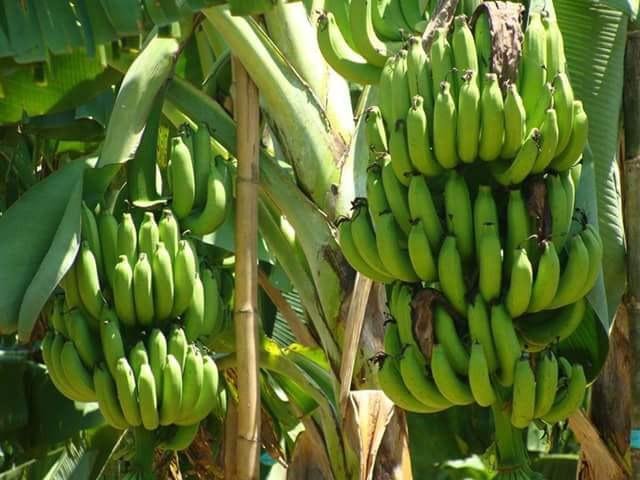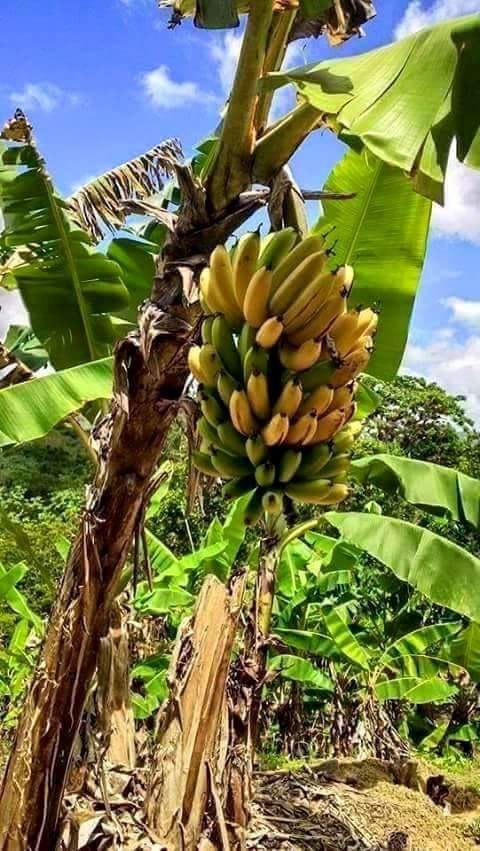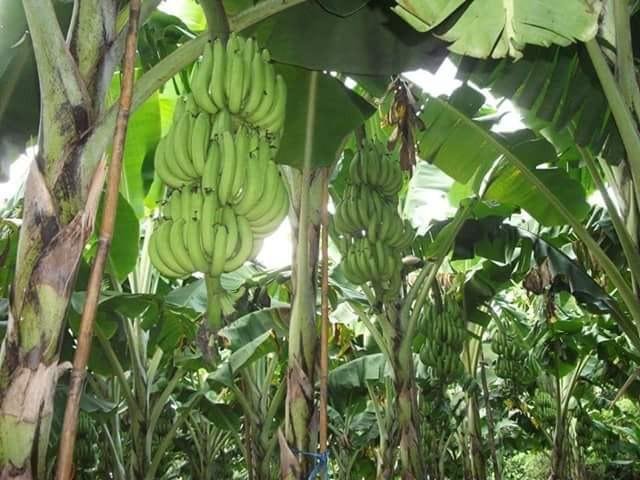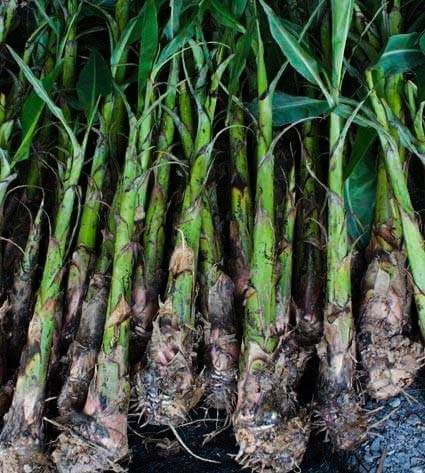Banana is a commodity most popular by the people of Indonesia. The reason for the fruits are yellow is a fairly affordable price and also contains nutrients and vitamins are enough to nourish the body.
Bananas are also a plant that can be said is not difficult to be cultivated. Because this plant in its care does not use too much fertilizer.
But in this article we are not so discuss about the definition of bananas, but rather lead to the characteristics of banana trees.
In general, bananas can live in areas high and low. This means that in banana cultivation we do not need to bother to find a good land surface.
In order for banana plants to grow properly then should be placed above the altitude of 100 mdpl (meters above sea level) with soil conditions slightly moist and open.
In addition to the above conditions, banana plants will grow and grow well if easily exposed to sunlight. Vice versa banana plants will not grow under puddles.
Do you know why? This is because the disease will arise which in the presence of this disease will affect the roots of banana trees to rot.
Similarly, banana plants can not live with a strong wind. Which can make the leaves tear.
# Morphology (Physical Characteristics) of Banana Trees First we start from the top of the leaf .. If we look carefully dark green banana leaf when it's adults and young green when new to grow.
Then the leaves are wide and long. Has a fibrous leaf bone with a compact leaf edge.
In terms of roots, the banana tree is rooted in fibers. With the growth of roots moving and gathering along the side of the tree along 4-5 meters.
This is the reason why banana trees are easily removed. In addition, the root of the tree itself can not reach the leih of 2 meters below the soil surface.
You need to know that the banana itself has flowers. Banana flowers can you look at the base for the female flowers while in the middle for male flowers.
This indicates that bananas are a group of perfect flowers. Because it has two reproductive tools namely male and female flowers.
The position of banana flower is located on each armpit between the protective leaf. As for the term banana flowers we often call the heart of bananas.
Bananas have 2 types of stems. That is the original rod and pseudo stems. The original stem is the stem which is located at the base of the stem all of which its position sinks under the surface of the ground.
The original rod itself has a collection of buds that will later produce roots. While the pseudo stem is a stem consisting of leaf-stem, erect and stand very sturdy above the soil surface.
Banana flower which then turned into bananas in general consists of several comb. Each comb has 7-21 bananas. And this depends on the type of banana and how to care for the banana tree itself.you may read on http://www.promusa.org
## After you get to know the characteristics of banana and the next is ### Practical Steps of Banana Cultivation
Climate
Banana plants are suitable for tropical climates with high humidity, and with fairly hot weather conditions. However, if the condition of your land in the subtropical or mountainous areas, no problem because the banana plant can adapt to cold weather. These plants can survive in areas that lack water, because bananas can supply water from stems that have a high water content, but the consequence of growth is not optimal. Note also with the condition of wind speed in the location of your land because if the wind speed in your land enough high can damage banana leaf and affect the growth of plantsThe good rainfall conditions for the cultivation of banana plants is in the range 1520-3800 mm per one time growing, with the assumption that once in a period of planting there are 2 months no rain. try in the cultivation of banana plants to make a bundle so there is no puddle of water.
Banana Cultivation Media
Banana plants can grow optimally on soil conditions that are rich in nutrients and contain lime or heavy soil. This plant has a greedy nature of food, so you need to prepare the land that has a high nutrient. You can do the fertilization to increase soil nutrients by using compost and manure. Banana planting should get intensive watering, but try not to have a pool of water in the land. Note also with ground water level conditions, for the wet area is 50-200 cm , while the half-wet area is 100-200 cm, and in dry areas 50-150 cm. Location of erosion-affected land will not produce a good banana fruit and this plant can not live maximally on a soil that has a salt content of 0.07%.
. # Elevation Place
The height of where the banana plant can grow in the lowlands to the plateau with an altitude above sea level. As for the banana ambon, banana horn, and banana jackfruit can grow well at an altitude of 1000 dpl.
B.## Stages of Banana Cultivation
Selection of Banana Seeds
Propagation of banana plants using vegetative means, the process of breeding through buds or banana children. Here are the requirements for breeding banana crops:
Requirements of good banana seedlings have a length of 1-1.5 meters with a diameter of about 15-20 cm. You should use seeds that come from healthy and fruitful breeding bananas. The height of saplings (seeds) of bananas can affect the productivity of bananas in fruiting (a real effect on the number of combs in each bunch) .There are two types of banana seedlings are young chicks and adult chicks. You should use adult puppies because usually already have flowers and food reserves in banana banana.Kami advocate, you choose the seedlings that have a pointy shaped like a sword, narrow leaf from pda using banana seedlings are broad-leaved.
Preparing Seeds
You can get banana seeds by buying at a farm nursery or using banana seedlings from your own garden. Use 2 × 2 meter spacing for banana cultivation. If you use your own breeder should limit the number of sapling shoots about 7-9 on banana indukan, if more than 9 buds should be cut to maintain the quality of seedling banana seedlings.
Before you plant seeds, sanitation should be done first to avoid transmission of pests and diseases. Here are the sanitation steps on banana seedlings:
After the seedlings are cut from the breeder immediately clean the soil attached to the roots Should first store the seeds 1-2 days in a shady location so that the wound after cutting dried, banana leaf fruit wide Do soaking the seeds to the extent of the stem neck using insecticide 0.5-1 percent within 10 minutes.
If you do not have insecticides no problem, you can use running water to soak the seed bulbs for 2 days.
If at the location of your land already contain pest nematodes, preferably soaked in hot water for a few minutes to turn off the pest.
. Processing Media Planting
Preparation of land for the cultivation of bananas should be considered all aspects from climate, soil contours, accessibility and so forth. Before planting a banana you should clean the weeds, wild grass and soil the soil if it is still solid, making drainage or drainage channels and making swales if the contours of the land are tilted.
Banana Cultivation Process
Determination of Plant Patterns
You can use intercropping cropping pattern in the first 3 months, because the banana plant has a fairly wide spacing. Types of intercropping plants that you can mated with banana plants are vegetables or seasonal plants.
Making Planting Hole
Recommended hole size is 50x50x50 cm for heavy soil type and 30x30x30 or 40x40x40 cm for loose soil type. Use plant spacing of 3.3 x 3.3 meters.
How to Planting
You should start planting bananas in September-October or before the rainy season. Before planting banana you should give organic fertilizer like manure or compost in each planting hole as much as 15-20 kg. The organic fertilizer you give greatly affects the taste quality of bananas.
Maintenance of Banana Crops
Thinning
In order to obtain a good planting result, preferably for one bunch of bananas there are 3-4 stems. Perform regular cutting of shoots / seedlings so that in one clump there are different kinds of seedlings that have different ages (growth phase). After reaching the age of 5 years, unload the clumps to be replaced by a new banana plant.
Weeding
Clean the weeds and grass that can disrupt the growth of mothers and banana seedlings. Perform weeding process at the time of crushing so that the roots and shoots of bananas can multiply. Banana root has a length of about 15cm below the soil surface, therefore you should not be deeply weeding process.
#:Breaking
Banana leaves that have begun to dry immediately pruned to maintain cleanliness and prevent the spread of pests. You can perform splinter activity at any time.
Fertilization
Banana plants require a large amount of potassium content in the soil. In 1 hectare of land, it takes 207 kilograms of urea, 138 kilograms of super phosphate, 608 kilograms KCl, and 200 kilograms of limestone as the main source of calcium. Nitrogen (Nitrogen) is given routinely 2 times a year which is placed on a runway that surrounds the banana plant. Finished fertilized, the runway sprinkled with the fertilizer is then covered with soil. As for potassium and phosphate pemupukam done 6 months after planting (2 times a year)
Watering and Watering
Banana plants can grow well if the irrigation is maintained. How irrigation can be watered or drain water between the rows of banana plants.
#:Fruit Maintenance
If the heart of banana is already 25 cm from the last banana comb, should be cutting process so that the growth of bananas is not disturbed.
When the fruit comb is fully expanding, bunches of bananas should be wrapped in clear plastic bags to keep fruit smooth to avoid pest destructive disease.
Use polyethylene plastic bags (can be purchased at plastic stores) 0.5 mm thick and given a hole with a diameter of 1.25 cm. Set it in such a way that the plastic can cover 15-45 cm to the top of the top of the comb and 25 cm under the fruit top of the bottom comb.
Banana Disease and Weed Pests
Banana Pests
Leaf caterpillar (Erienota thrax.)
Part of the banana attacked is a leaf.
Attack symptoms: the leaves are rolled up like a chimney and tear up the leaf bone.
How to control: using a suitable insecticide is not available, you can try using insecticide Malathion.
Uret beetle (Cosmopolites sordidus)
Part of the banana that is attacked the petals, stems.
Symptoms of attack: the alleys up or down in the petals, stems of banana plants full of alleys.
How to control: sanitation on banana clumps, immediately clean the clumps from the remnants of banana stems, use seeds that have been sanitized
Nematodes (Rotulenchus similis, Radopholus similis).
The part of the banana that is attacked is the root.
Symptoms of attack: the banana plant looks miserable, found in the cavity or small spots on the roots, swollen roots.
How to control: wear seeds that have been sanitized, multiply the element of soil moisture content and use the land with a small clay content.
Banana Disease
Blood disease
Cause: Xanthomonas celebensis (bacteria).
Part of banana attacked is the inner banana plant tissue
Symptoms of an attack: the banana tissue becomes reddish as it bleeds
Control: dismantle and burn sick banana plants
Panama
Cause: Fusarium oxysporum fungus attack
Part of the attacked banana is a leaf
Symptoms of attack: leaves withered and broken, the first attack on the outer leaves and then the inner leaves, banana leaves split longitudinally, will issue a black sap vessels.
How to control: dismantle and burn sick banana plants
Leaf spots
Cause: Cercospora musae mushroom.
Part of the banana is attacked the leaves appear symptoms of mature brown spots are increasingly widespread.
How to Control: use a fungicide containing Copper oxide or Bordeaux Porridge (BB).
bananas withered
Cause: Bacillus bacteria
Part of the banana that is attacked is the root.
Symptoms of attack: plants withered and then died.
How to control: dismantle and burn sick banana plants
#:Leaf shoots
Cause: virus infection through intermediate aphids Pentalonia nigronervosa
Part of the banana that is attacked is shoot leaves.
Attack symptoms: banana shoots grow uprightly in groups
How to Control: dismantle and burn sick banana plants
Weeds on Banana
Usually shortly after planting banana and adult stage of canopy has begun to form, weeds become one of the problems that must be addressed. How to control it as follows:
Use herbicides such as Gesapax 80 Wp, Round ups, Paraquats and dalapons. Plant ground cover crops that can withstand erosion, are resistant to shade, not easily attacked by pests, not creeping plants. For example Geophila repens.Tutup land with polyethylene plastic.
Harvest Banana Fruit
Bananas can be harvested green with round circle of fruit and angle does not menyiku. The age of ready-to-harvest bananas is between 100 - 120 days after the appearance of the flowers (may depend on cultivars or clones planted). In order for the maturation process to be uniform and simultaneous, it should be stimulated using materials such as smoke from burnt leaves, fresh leaves (acacia leaves), carbide, ethrel / ethepon, propylene, acetylene, duration of about 10-12 hours.
post-harvestBanana Fruit
Banana fruit harvesting fruit can be packed directly using bamboo basket and immediately transported to distributor or market. If you want to deposit bananas to modern markets, supermarkets and supermarkets, you can do packing per comb or per some fruits according to the demands of the modern market. The appearance of bananas greatly affects the sale of bananas in the modern market.
That's the article sipendik about How to Practice Banana Cultivation for Abundant Harvest, may be useful for you who want to start a banana cultivation business.
Thanks and best wishes ..






Hi, fo0076! I just resteemed your post!
I can also re-steem and upvote some of your other posts
introduction post
Curious? Check out @resteembot's' PS: If your reputation is lower than 30 re-blogging with @resteembot only costs 0.001 SBD
Hi! I am a robot. I just upvoted you! Readers might be interested in similar content by the same author:
https://steemit.com/science/@fo0076/practical-ways-of-banana-cultivation-for-abundant-harvest-20171019t19254352z
Usefull post sir
Wow they look amazing. I never saw a banana field before. Thanks for sharing.
Actually banana is my favorite fruit and I tried many types and all of them are nice.